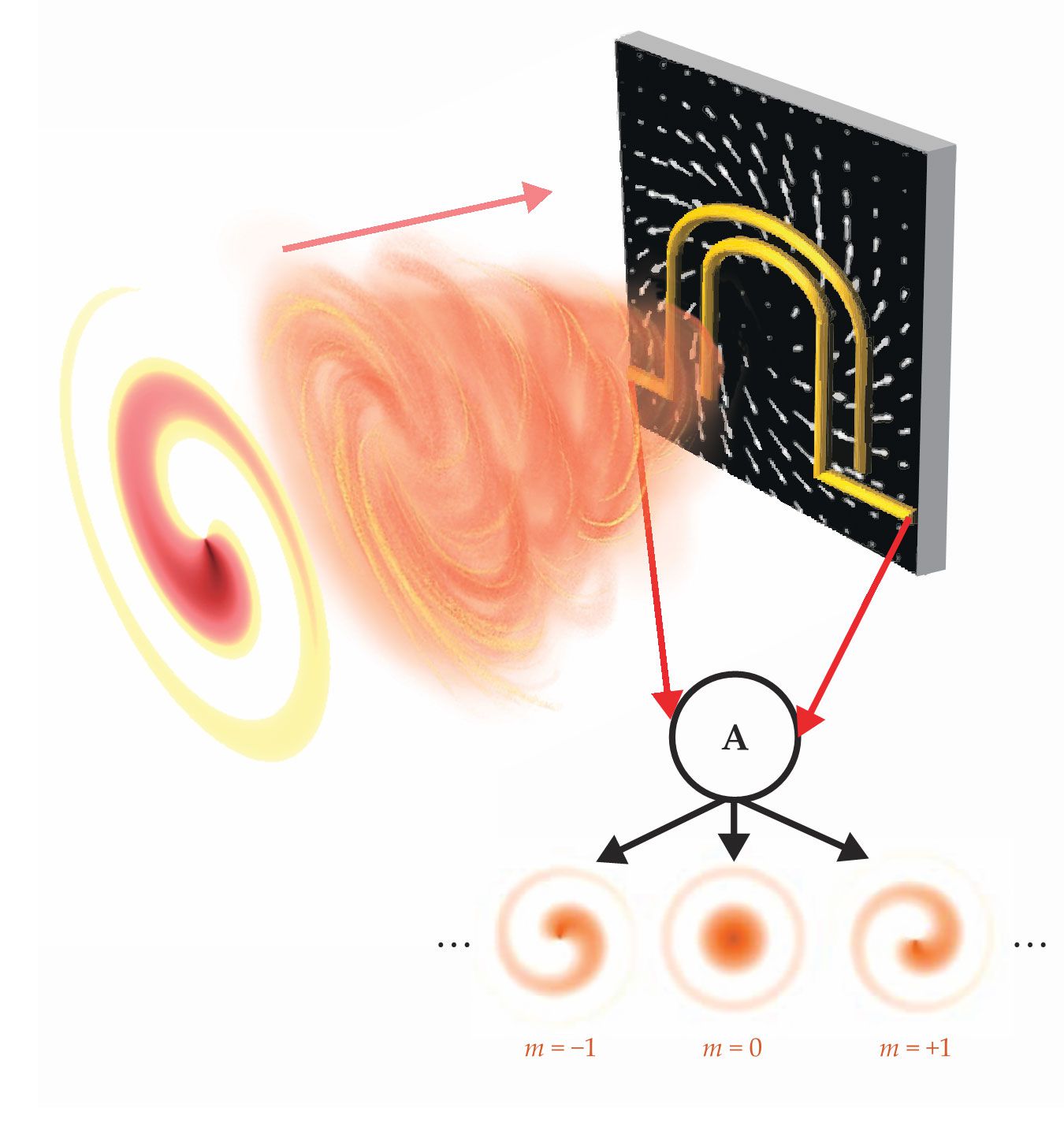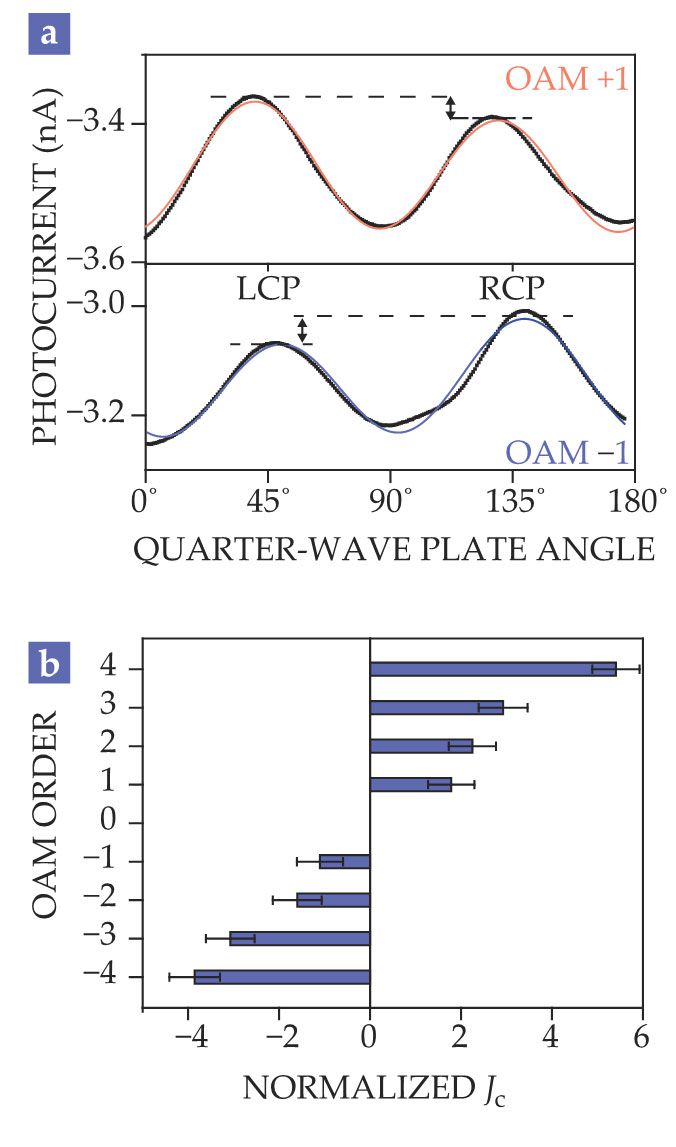Chip-scale sensor detects light’s orbital angular momentum
DOI: 10.1063/PT.3.4518
Light often has spin angular momentum, more commonly referred to as left or right circular polarization. Only in the past 30 years have researchers been able to impart orbital angular momentum (OAM; see the article by Miles Padgett, Johannes Courtial, and Les Allen, Physics Today, May 2004, page 35
OAM provides additional degrees of freedom for encoding information in optical communications. Modern optical networks rely on wavelength and intensity modulations to send data; the addition of polarization and OAM could pack in more information without boosting traffic. What’s more, unlike polarization, which has two modes, m can take any integer value. Modes of different m are also orthogonal and wouldn’t interfere with one another during transmission.
Ordinarily, measuring OAM requires a roomful of bulky optics. But Ritesh Agarwal at the University of Pennsylvania and his colleagues have found a compact way to detect light’s OAM through the induced photocurrent in a device that’s just tens of micrometers across. 1 Their technique could make it easier to read out information encoded in the OAM.
Gaining momentum
To measure m, researchers typically interfere light with a reference beam or send it through a hologram or specially designed aperture. The nature of the interference or diffraction pattern manifests the OAM. But those measurements not only require table-scale setups; they are also limited in the number of modes they can measure. For example, most holograms can detect only one particular value of m, so a new one must be swapped in for each mode.
In CCDs and other solid-state sensors, light is detected through its interactions with matter. A material’s response depends primarily on the local incident number of photons—that is, the intensity. Phase information is usually lost when intensity is converted to photocurrent. Because a clockwise helical wavefront and a counterclockwise one have the same donut-shaped intensity profile, a phase-sensitive measurement is essential for characterizing light with OAM without introducing holograms and apertures.
Agarwal has been contemplating such a measurement for five years. Back in 2015 he and his team found a way to detect a light beam’s circular polarization—its spin angular momentum—with a silicon nanowire. 2 They were interested in extending the capability to OAM but weren’t sure how to do it. A couple years later, a breakthrough came when the team was trying to understand the properties of a new group of materials, Weyl semimetals.
Mean-Weyl …
Identified for the first time in 2015, Weyl semimetals have a broken symmetry, generally inversion symmetry, that allows them to host quasiparticles that behave as Weyl fermions—massless, charged, and chiral. (For more on Weyl semimetals, see Physics Today, December 2019, page 24
Photocurrents in most materials depend only on the light’s local intensity. But when excited at a normal angle, a crystal with mirror symmetry reacts not to the local intensity but to how the local intensity compares with the surrounding intensities, or the intensity gradient. In that case, the photocurrent is nonlocal and results from an imbalance, in both real and momentum space, in the density of excited electrons. Mathematically, it is described by the terms beyond the dipole approximation in the multipole expansion of the light–matter interactions. The symmetry cancels out the dipole response, which would otherwise obscure the other terms. Although Weyl semimetals aren’t the only materials with the requisite symmetry, they have the added advantage of a nonlinear optical response that’s among the largest identified to date.
In their intensity-gradient experiment, the researchers measured a circular photocurrent that could be explained only by the nonuniform distribution of the light. But in addition to a nonuniform intensity, light with nonzero OAM has a circling phase gradient that depends on m. Could a photocurrent sense a phase gradient as well? The group’s calculations indicated that the measurement should be possible.
A new phase
Agarwal and his graduate student Zhurun Ji prepared a 50- to 200-nm-thick layer of the Weyl semimetal tungsten ditelluride and designed U-shaped electrodes, shown in figure
Figure 1.

Light with orbital angular momentum (OAM; peach swirl on the left) excites photocurrents in a material (black rectangle). Usually, the photocurrent depends only on the light intensity, which doesn’t vary with OAM. But in materials with the right symmetry, it arises in part from light’s phase gradient (white arrows)—that is, the transfer of OAM from photon to electron. Using specially designed U-shaped electrodes (yellow), researchers measure the photocurrent with an ammeter (A) to determine the OAM quantum number m. (Adapted from ref.

Before reaching the WTe2 detector, a beam with OAM passes through a rotating quarter-wave plate that cycles the polarization from 0° linear to left circular to 90° linear to right circular and back to 0° linear. The measured radial photocurrent, shown in figure
Figure 2.

A Weyl semimetal’s photocurrent is sensitive to light’s orbital angular momentum (OAM). (a) Before reaching a thin layer of tungsten ditelluride, light passes through a rotating quarter-wave plate, which cycles the polarization from linear to left circularly polarized (LCP) to orthogonal linear to right circularly polarized (RCP) and back to the original polarization. Part of the current depends on circular polarization and leads to the difference in the left and right photocurrent peaks, which correspond to LCP and RCP. That difference is around the same magnitude but swapped for OAM +1 (upper curve) and −1 (lower curve). (b) The photocurrent component Jc that varies with circular polarization is proportional to the magnitude and helicity of light’s OAM. (Adapted from ref.

The photocurrent is not the same for left and right circular polarization states (the left and right peaks in figure
To complement the chip-scale detection of OAM, researchers have reduced the production of light with OAM to chip-scale too. Published back to back with Agarwal’s paper, the University of Pennsylvania’s Liang Feng and his colleagues report producing light with five different OAM values with the same microlaser. 4 In their scheme, light circling in a microscale semiconducting ring was scattered by ridges on the inner surface of the ring such that the light’s circling became a helical propagation. Control over the OAM chirality came from two waveguide arms, one pumped in clockwise light and the other, counterclockwise.
References
1. Z. Ji et al., Science 368, 763 (2020). https://doi.org/10.1126/science.aba9192
2. S. Dhara, E. J. Mele, R. Agarwal, Science 349, 726 (2015). https://doi.org/10.1126/science.aac6275
3. Z. Ji et al., Nat. Mater. 18, 955 (2019). https://doi.org/10.1038/s41563-019-0421-5
4. Z. Zhang et al., Science 368, 760 (2020). https://doi.org/10.1126/science.aba8996
